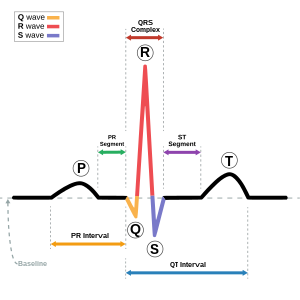Long QT syndrome
| Long QT syndrome | |
|---|---|
 |
|
| Schematic representation of normal ECG trace (sinus rhythm) with waves, segments, and intervals labeled. The QT interval is marked by blue stripe at bottom. | |
| Classification and external resources | |
| Specialty | Cardiology |
| ICD-10 | I45.8 |
| ICD-9-CM | 426.82 |
| DiseasesDB | 11104 |
| eMedicine | med/1983 |
| MeSH | D008133 |
Long QT syndrome (LQTS) is a rare congenital and inherited or acquired heart condition in which delayed repolarization of the heart following a heartbeat increases the risk of episodes of torsades de pointes (TdP, a form of irregular heartbeat that originates from the ventricles). These episodes may lead to fainting and sudden death due to ventricular fibrillation. Episodes may be provoked by various stimuli, depending on the subtype of the condition.
The condition is named for the appearance of the electrocardiogram (ECG/EKG) on which a prolongation of the QT interval occurs. Normally, the QT interval duration is between 350 and 440 milliseconds. In some individuals, the QT prolongation occurs after the administration of certain medications, which may be dangerous. In addition to medications, long QT syndrome can be acquired from too low blood potassium or low blood magnesium, as in anorexia nervosa.
Many people with long QT syndrome have no signs or symptoms.
Some people may experience the following symptoms:
Risk factors for long QT syndrome include the following:
Anorexia nervosa has been associated with sudden death, possibly due to QT prolongation. It can lead a person to have dangerous electrolyte imbalances, leading to acquired long QT syndrome and can in turn result in sudden cardiac death. This can develop over a prolonged period of time, and the risk is further heightened when feeding resumes after a period of abstaining from consumption. Care must be taken under such circumstances to avoid complications of refeeding syndrome.
...
Wikipedia
